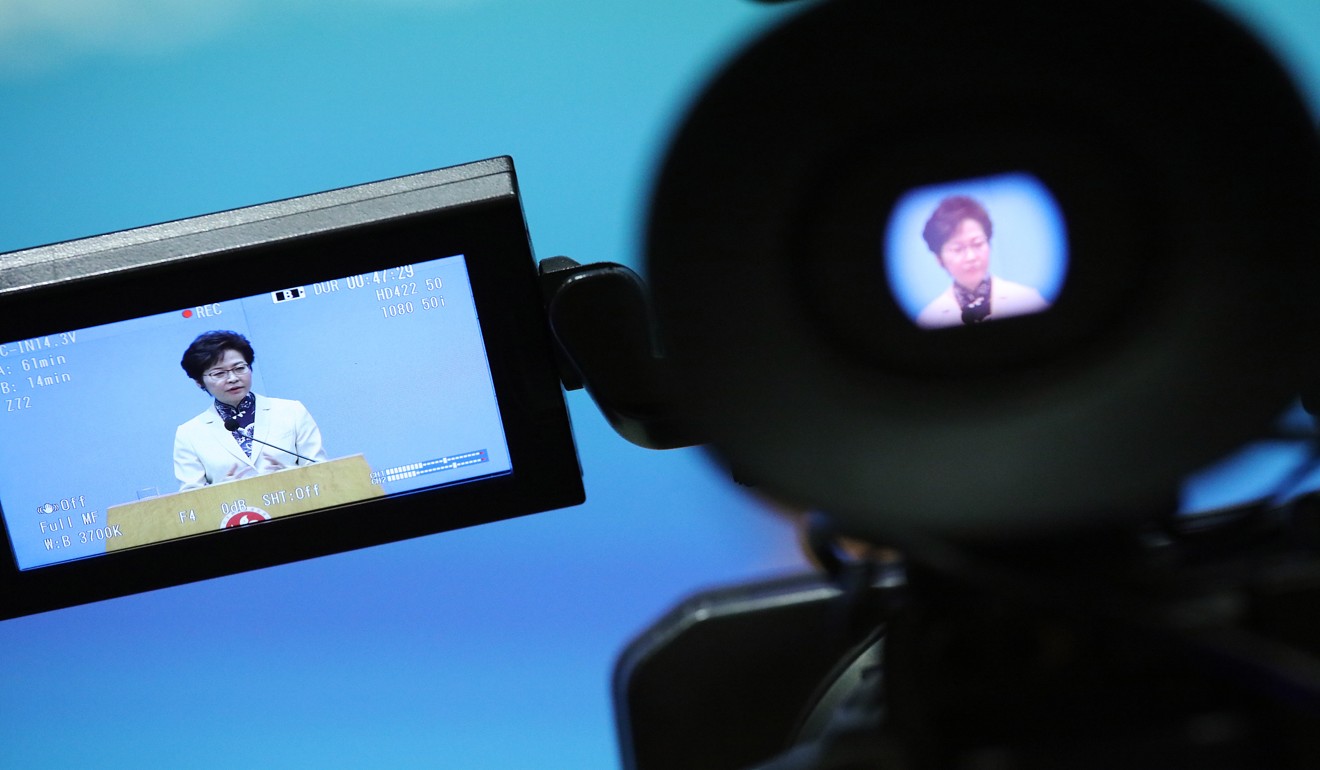
Carrie Lam steers clear of politics, pledges billions on technology sector and new housing schemes
In a concise 40-minute speech, Lam stays focused on the economy, outlining major cuts to tax rates and plans to expand innovation and technology sector
- Plan to double gross domestic spending on research and development
- Profits tax for companies cut in half to 8.25 per cent for first HK$2 million
- 300 per cent tax deduction for the first HK$2 million companies spent on R&D
- New “Starter Homes” scheme to help young families own a home
- All residents will have a single digital identity as part of smart city blueprint
- Plan to expand convention centres leaves Wan Chai Sports Ground untouched
- Initiative to bring more youth into government
Hong Kong leader Carrie Lam Cheng Yuet-ngor has pledged to spend billions to catapult the city into the information technology age and “rekindle hopes” of more families becoming homeowners, in a maiden policy address that studiously downplayed contentious political issues.
Setting out her economic agenda, Lam announced moves to slash tax rates for businesses and fund billions more in tax deductions for research and development.
The profits tax rate would be halved to 8.25 per cent for the first HK$2 million of net gains – the much-anticipated tax break that was a campaign promise and one that would cost the government HK$5.8 billion in forfeited revenue a year.
The chief executive outlined her government’s goal to double the gross domestic spending on research and development from the current 0.73 per cent of the GDP to 1.5 per cent within her five-year term.
The 0.73 per cent ratio is equivalent to HK$18.18 billion based on last year’s GDP.
Lam also anticipated a brighter-than-expected economic outlook for Hong Kong, with overall growth this year expected above 3.5 per cent, on par with an earlier forecast between 3 and 4 per cent.
But to sustain this trend, “diversifying our economy is the only solution”, she said.
“In the face of competition from other economies as well as the rise of protectionism in recent years, Hong Kong is facing increasingly grave challenges. We must develop a high value-added and diversified economy.”
Part of that diversification is the innovation and technology sector, in which Hong Kong, she lamented, was far behind.
Carrie Lam in her own words: Hong Kong people are still ‘brilliant’
Along with more than HK$10 billion set aside for university research funding, she said she would provide additional tax cuts to encourage companies to invest in research and development.
She proposed that the first HK$2 million spent on R&D would see a 300 per cent tax deduction with spending above that seeing a 200 per cent cut.
Lam will lead a new high-level interdepartmental steering committee on innovation and technology, while a Chief Executive’s Council of Advisers on Innovation and Strategic Development will be formed by revamping the existing economic development commission and the commission on strategic development.

Lam said she wanted to make Hong Kong a “smart city”, which included a unified “eID” for every Hong Kong resident to facilitate online transactions as well as installing smart lamp posts to collect real-time city data for traffic management.
She also unveiled her plans to counter Hong Kong’s dubious distinction of being the most expensive city in the world to buy a home. She promised to increase the land supply and launch a subsidised “starter homes” scheme to help middle-class, first-time buyers.
“Meeting the public’s housing needs is our top priority,” she said, as she stressed that she wanted to “rekindle the hopes of families in different income brackets to become homeowners”.
While details of her “starter homes” scheme will not be available until the middle of next year, she said a pilot scheme by the end of next year will offer about 1,000 residential units in Kwun Tong.

The income limits for the new scheme would be HK$34,000 a month for single-member households and HK$68,000 for households with two or more members.
And as part of her commitment to push for homeownership, Lam said that future public housing estates should include more units for those who qualify for subsidised rentals to instead buy homes.
As a first step, 4,000 public rental units being built in Sha Tin will be converted into so-called Green Form Subsidised Home Ownership Scheme units for sale in late 2018.
The scheme caters specifically to people who rent public housing, encouraging them to leave their units for others on the public rental housing waiting list. It was also in line with Lam’s policy of boosting the home-ownership rate in Hong Kong.
In a bid to absorb more young minds into the government, Lam increased the ratio of youth members on government committees to 15 per cent.
7 things you need to know from Hong Kong leader Carrie Lam’s policy address
The government is also expected to hire 20 to 30 young people on contract basis to the revamped Central Policy Unit, which will be renamed Policy Innovation and Co-ordination Unit.
But Senia Ng Sze-nok, a barrister and a rising young star in the liberal Democratic Party, expressed caution.
“It would depend who the government is to appoint. The last thing we want to see is that the government appoints a group of pro-government young people to its advisory bodies,” said Ng.
To bolster Hong Kong’s status as a leader in hosting conventions and exhibitions, Lam said the government would demolish three government buildings next to the Hong Kong Convention and Exhibition Centre in Wan Chai and build a new wing with the potential of adding 23,000 square metres of facilities.

By doing so, she also scrapped a controversial plan by her predecessor Leung Chun-ying to tear down the Wan Chai Sports Ground to build a new exhibition facility.
On improving people’s daily lives, she said she would introduce a plan to subsidise public transport. For commuters who use an Octopus card, the government would subsidise 25 per cent of monthly expenses incurred after HK$400, subject to a cap of HK$300 a month. This subsidy will cost the government around HK$2 billion annually. The beneficiaries: two million commuters.
Lam touched on strengthening retirement protection, saying a proposal to reform the Mandatory Provident Fund would be put forward “in the coming months”. There had been calls to cancel the fund’s so-called offset mechanism, which allows employers to use money put into staff retirement funds to offset severance and long service payments.
Are you satisfied with Carrie Lam’s maiden policy address?
“To secure public support for the government, we must adopt a people-oriented approach and be attentive to the needs of the people,” said Lam.
She announced an array of initiatives in this regard in the policy address, including increasing the monthly payment of low-income working family allowance by 23 per cent from the current HK$2,600 to HK$3,200 for eligible households.
During her 40-minute speech, she avoided sensitive issues such political reforms, or enacting the national security law.
She also resisted using the word “independence” even as she urged Hongkongers to have “the obligation to say ‘no’ to any attempt to threaten our country’s sovereignty, security and development interests, as well as the duty to nurture our next generation into citizens with a sense of national identity, an affection for Hong Kong and a sense of social responsibility.”
Heeding President Xi Jinping’s message at her inauguration in July, she said: “Everybody with a passion for Hong Kong has the responsibility to ensure that, here in Hong Kong, ‘one country, two systems’ advances in the right direction.”
In her concluding remarks, Lam sought to rally the city, as she said Hongkongers remained a “brilliant people” and the city imbued with intrinsic advantages that could keep it on top.
After her tight 40-minute speech that garnered applause in the Legislative Council, Lam’s office issued a 49,000-word Policy Address, expanding on her key themes of “hope and happiness” to build a more unified and harmonious Hong Kong.
Speaking to the press later, Lam fielded a volley of questions on politics, including on independence. She had not spoken on independence, she replied, because the issue had not surfaced from the consultations she held on what to talk about in her address – hinting this was a fringe cause.
As for political reforms, Lam said she would wait until there was the right social atmosphere, citing as an example when she got proper respect from Legco. When she entered the chamber yesterday, several opposition lawmakers had shouted slogans at her. “I have shown much respect towards the Legco… but how did they treat me as I walked into the Legco chamber today? … If I can enter the Legco peacefully one day and receive the most basic respect from all the lawmakers, maybe that is the time to reactivate these controversial moves.”

She also said Hong Kong should grab the opportunity offered by mainland China’s ambitious infrastructure programmes, highlighting the Belt and Road Initiative and the Greater Bay Area development.
In concluding her speech, she called for unity.
“My vision is for a Hong Kong of hope and happiness – a city we are all proud to call our home,” she said. “To achieve this vision, we need to have a society that is united, harmonious and caring. Let’s connect for hope and happiness.”
After her speech, Lam addressed criticism that she avoided contentious political issues.
“This policy address is to reflect what we have heard from the community in the last few months. So, it is not my personal choice to make it a political or non-political policy address,” she said.
When asked about football fans booing the national anthem at matches, she said those that disrespected the March of the Volunteers were a tiny minority in the city.
“They do not have the support of the majority of Hong Kong people. Hong Kong is an inalienable part of our country. Under ‘one country, two systems’, we are a special administrative region. The national anthem, just like the national flag and emblem, should be respected.”

